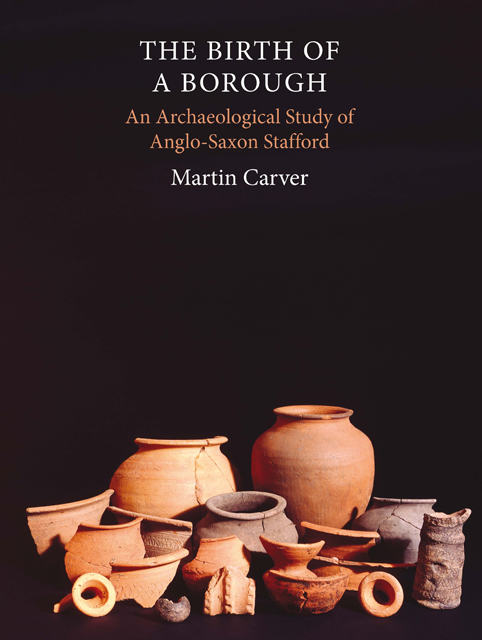Book contents
- Frontmatter
- Contents
- List of Illustrations
- Preface
- Acknowledgements
- Abbreviations
- 1 Questions
- 2 Digging up Stafford: Evaluation and Design
- 3 Seven Windows on Early Stafford: The Principal Investigations
- 4 Æthelflæd’s Town
- 5 Aftermath: Norman and Medieval Stafford
- 6 Anglo-Saxon Stafford in Context
- Digest A1 Archaeological Interventions at Stafford to 1988
- Digest A2 Dendrochronological and Radiocarbon Dates
- Digest A3 Pottery Seriation
- Digest A4 Key to Pottery Illustrations
- Digest A5 Excavated Structures
- Digest A6 Contents of the Stafford Online Archive: http://ads.ahds.ac.uk/catalogue/archive/stafford_eh_2009
- Bibliography
- Index
3 - Seven Windows on Early Stafford: The Principal Investigations
Published online by Cambridge University Press: 17 February 2023
- Frontmatter
- Contents
- List of Illustrations
- Preface
- Acknowledgements
- Abbreviations
- 1 Questions
- 2 Digging up Stafford: Evaluation and Design
- 3 Seven Windows on Early Stafford: The Principal Investigations
- 4 Æthelflæd’s Town
- 5 Aftermath: Norman and Medieval Stafford
- 6 Anglo-Saxon Stafford in Context
- Digest A1 Archaeological Interventions at Stafford to 1988
- Digest A2 Dendrochronological and Radiocarbon Dates
- Digest A3 Pottery Seriation
- Digest A4 Key to Pottery Illustrations
- Digest A5 Excavated Structures
- Digest A6 Contents of the Stafford Online Archive: http://ads.ahds.ac.uk/catalogue/archive/stafford_eh_2009
- Bibliography
- Index
Summary
The sum of all the observations made to date offers a rough guide to the occupation of the Stafford peninsula and the legibility of its strata (Chapter 2). However, the type of intimate sequence that new history demands is only available from targeted excavation and sampling. Accepting that these need to encompass major questions and produce accessible results, it can be argued that there have been seven of them to date: excavations at St Bertelin's church (ST01), excavations in the town centre at Bath Street (ST34) and St Mary's Grove (ST29), excavations in the industrial area at Tipping Street (north) (ST32), excavations in 1975 on the periphery of the peninsula at Clarke Street (ST15) and investigations of the pollen sequence in the former King's Pool. To these we may now add the 2003–2006 rescue excavation at Broadeye, which is also summarised below (Fig. 3.1).
That is not say that other observations and excavations have no value; on the contrary, every wellrecorded archaeological intervention in every town has the capacity to illuminate the past, just as the painting of a landscape is composed from a thousand brush-strokes. But for history we require actors, or the archaeological equivalent: dated activities in context. And for this we need excavation on a broad scale, especially when, as here, very little was previously known of the period or the place. Accordingly I propose to summarise and review here the basic sequence of events dug up at each of these interventions, leaving evocations of the Late Saxon and medieval towns until Chapters 4 and 5 respectively.
St Bertelin's (FR3; 1 on Fig. 3.1)
Excavations by Adrian Oswald (then of Birmingham City Museum) were undertaken in 1954 at the west end of St Mary's church. Here he found a set of stone foundations interpreted as belonging to the documented medieval chapel of St Bertelin, and among them a set of post-holes with a central grave-shaped pit containing a large lump of oak (Figs 3.2, 3.3, 3.4). The latter object was interpreted as a wooden cross of the Anglian period (seventh–ninth centuries) and was reconstructed as such at the site and on the cover of the report (Fig. 3.5). C. A. Ralegh Radford saw the object as a preaching-cross that had preceded the construction of a timber chapel.
- Type
- Chapter
- Information
- The Birth of a BoroughAn Archaeological Study of Anglo-Saxon Stafford, pp. 21 - 57Publisher: Boydell & BrewerPrint publication year: 2010



